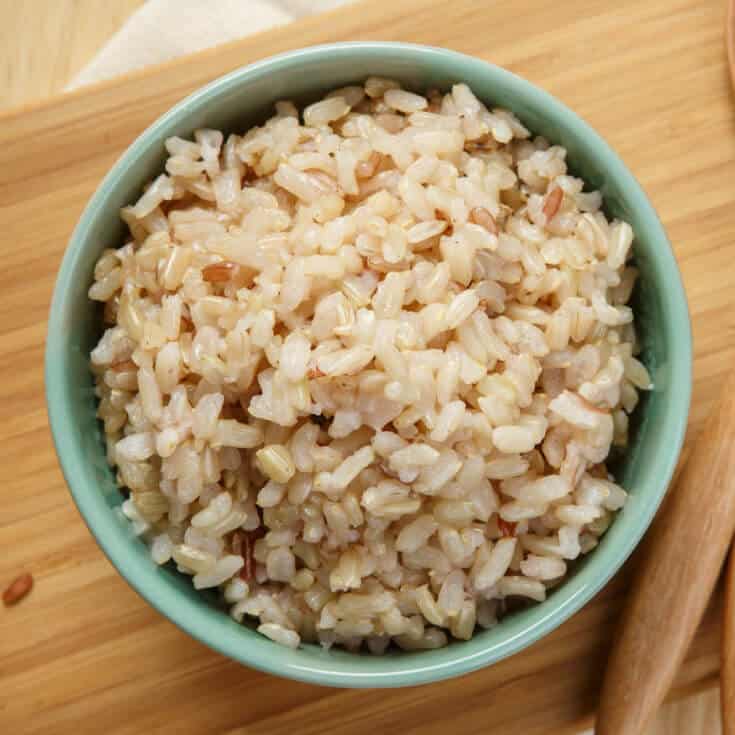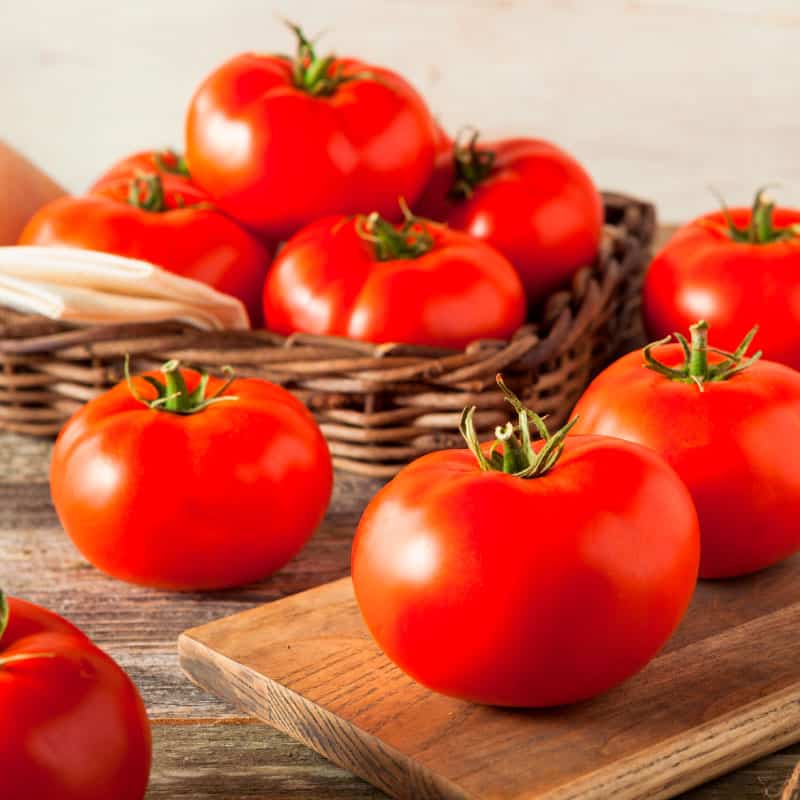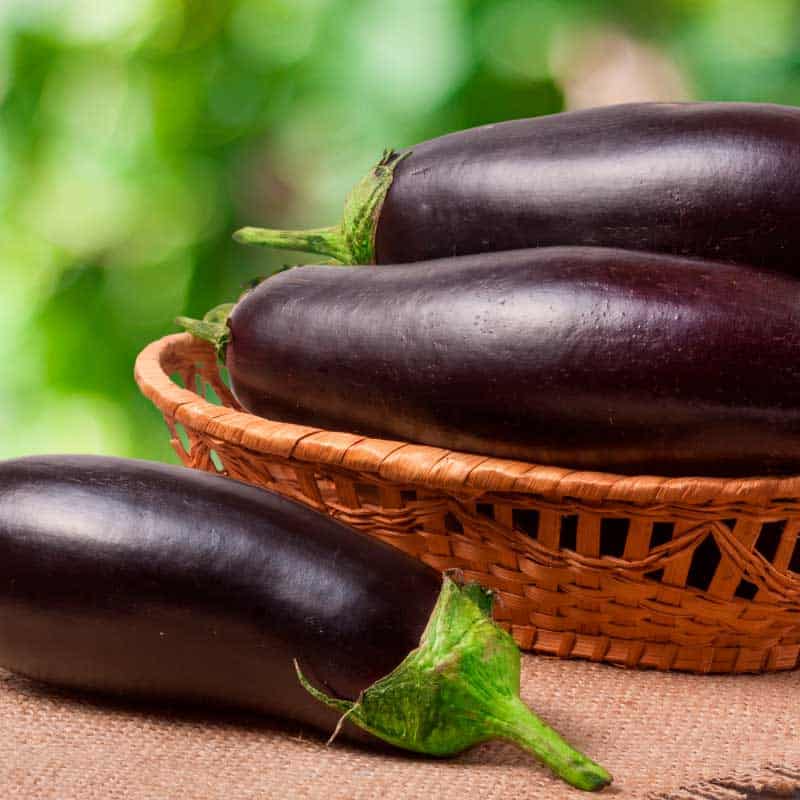This Dr. Axe content is medically reviewed or fact checked to ensure factually accurate information.
With strict editorial sourcing guidelines, we only link to academic research institutions, reputable media sites and, when research is available, medically peer-reviewed studies. Note that the numbers in parentheses (1, 2, etc.) are clickable links to these studies.
The information in our articles is NOT intended to replace a one-on-one relationship with a qualified health care professional and is not intended as medical advice.
This article is based on scientific evidence, written by experts and fact checked by our trained editorial staff. Note that the numbers in parentheses (1, 2, etc.) are clickable links to medically peer-reviewed studies.
Our team includes licensed nutritionists and dietitians, certified health education specialists, as well as certified strength and conditioning specialists, personal trainers and corrective exercise specialists. Our team aims to be not only thorough with its research, but also objective and unbiased.
The information in our articles is NOT intended to replace a one-on-one relationship with a qualified health care professional and is not intended as medical advice.
Are Black Garlic Benefits Even More than Raw Garlic?
August 19, 2019
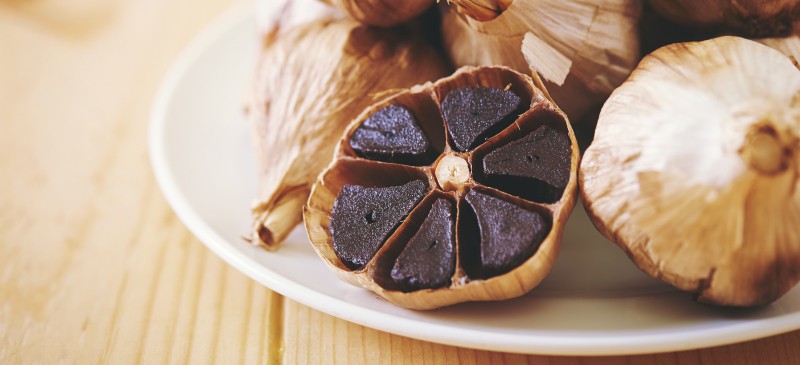
At first glance, black garlic may look like it’s been sitting out for way too long, but this form of garlic commonly seen in Asian cuisines is beginning to grow in popularity here in the states.
Once considered a secret ingredient found only on the shelves of specialty markets and on the menus of high-end restaurants, black garlic has recently become a favorite of foodies looking to amp up the flavor and nutritional content of their dishes.
This unique ingredient is made from Allium sativum, or regular garlic, and even shares many of the same health benefits as raw garlic, from preserving cognitive function to protecting heart health and more.
However, there are plenty of differences between the two, with black garlic boasting a higher concentration of antioxidants and a distinct texture, taste and aroma all its own.
This form of aged garlic allows for a unique and pleasant taste. Sneak it into a meal for a dinner party and you’ll have your guests questioning the secret ingredient for hours.
What Is Black Garlic?
Black garlic is produced by allowing regular garlic to age in temperatures between 140–170 degrees Fahrenheit for a period of three to four weeks. This allows it to undergo the Maillard reaction, a chemical process that occurs between amino acids and reducing sugars.
Not only does this reaction give the garlic a dark color, chewy texture, and distinct flavor and aroma, but it also enhances the nutritional value of this superfood even more.
The black garlic taste is usually described as tangy with a syrupy, balsamic flavor. It works well in savory and sweet dishes alike and can be used in everything from meat blends to desserts.
It’s even available in powdered form to provide an extra dose of flavor with minimal effort required.
When looking at the difference between black garlic and regular garlic, it really comes down to the reduced content of allicin in the latter. Because of its allicin content, fresh garlic has a stronger, more offensive flavor.
This slow-cooking process eventually turns the garlic cloves dark and gives them a sweet taste. It also alters the clove’s consistency, making them chewy and jelly-like, almond like dates.
For centuries, it has been consumed in Japan, South Korea and Thailand. More recently, it was introduced to Taiwan and other countries, and then got the attention of high-end chefs in the states. Today, chefs are using it to add unique flavors to fish, chicken, risotto and soup recipes.
Benefits
1. Loaded with Antioxidants
Antioxidants are compounds that can have a powerful effect on health. They work by neutralizing harmful free radicals to prevent oxidative stress and damage to cells.
According to a critical review published in the Journal of Food and Drug Analysis, black garlic demonstrates much higher biological activity than fresh garlic, including its antioxidant properties.
Another study, this one out of South Korea, found that allowing garlic to age over a 35-day period to form black garlic causes a significant increase in the antioxidant content, reaching peak antioxidant levels on the 21st day of aging.
During the aging process, the allicin in garlic is converted into antioxidant compounds, including alkaloids and bioflavonoids. While black garlic is slowly cooking, it’s going through a fermentation process that converts its phytochemical compounds.
The antioxidants that emerge have the ability to regulate cell signaling and reduce inflammation. Plus, they have neuroprotective, antithrombogenic, antidiabetic and anticancer activities.
2. Helps Fight Cancer Growth
A systematic review published in the International Journal of Preventive Medicine found that intakes of aged garlic are inversely associated with cancer. Twenty-five studies that focused on cancer incidences and aged garlic exposure were evaluated for the review, with results from human, animal and lab studies having mostly consistent reports.
A 2014 in vitro study showed that aged black garlic extract was able to effectively kill off and reduce the growth of colon cancer cells. Similarly, another in vitro study published in the journal Nutrition and Research Practice reported that aged black garlic extract decreased the growth and spread of leukemia cells as well.
Researchers believe that the anticarcinogenic effects of aged garlic is from its antioxidant compounds. The phenolic compounds, in particular, are significantly higher in aged garlic than raw garlic.
The components of aged garlic have been linked to tumor markers reduction and help block the buildup of free radicals to inhibit the growth and spread of cancer cells in the body.
3. Boosts Heart Health
One of the most well-known garlic benefits is its ability to protect and improve the health of your heart. Black garlic may also help enhance heart health, with some studies even showing that it may be just as effective as raw garlic.
A 2018 animal model compared the effects of black garlic and raw garlic on heart health recovery following damage caused by ischemia, or a lack of blood supply to the heart muscles. Interestingly, researchers found that both raw garlic and black garlic exhibited cardioprotective effects and were equally effective in minimizing damage to the heart.
Another animal model conducted at Dankook University in Korea also showed that it was able to lower levels of cholesterol and high triglycerides to reduce the risk of heart disease.
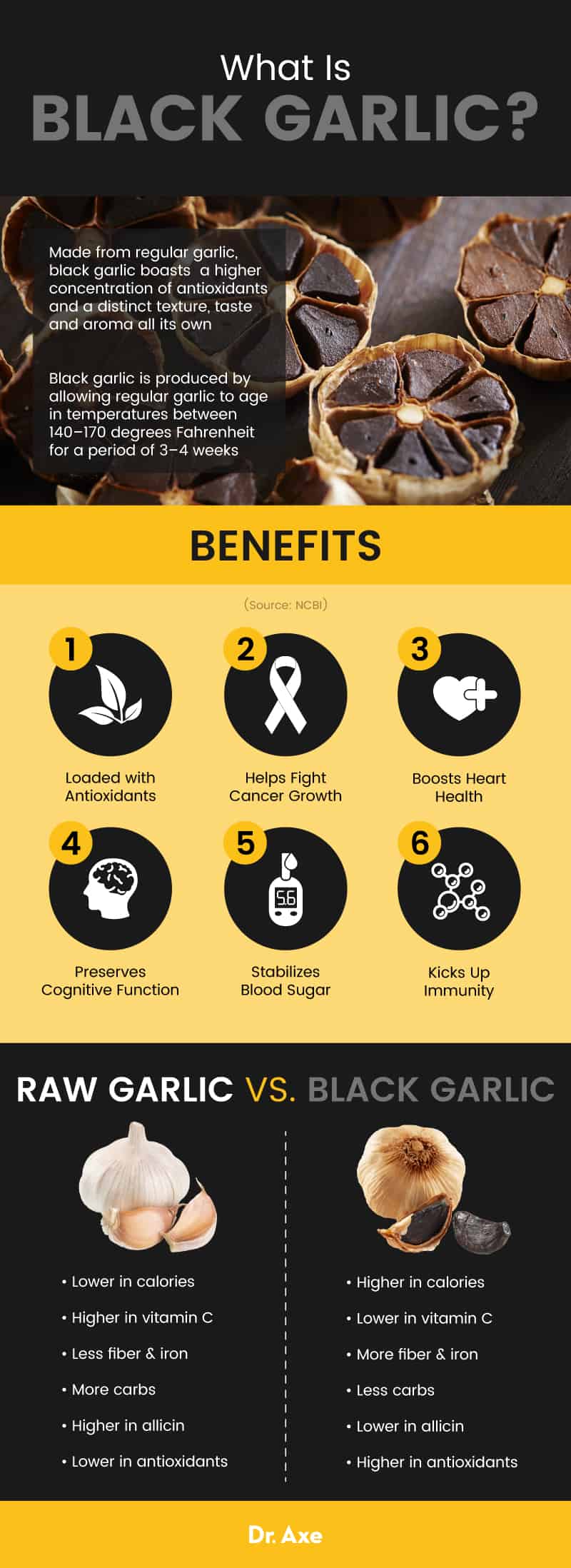
4. Preserves Cognitive Function
Much like regular garlic, black garlic can have a powerful effect on brain health. Because it’s rich in antioxidants, it can alleviate inflammation and may aid in the prevention of cognitive conditions like dementia, Alzheimer’s disease and Parkinson’s disease.
A recent animal model published in Nutrients showed that aged garlic extract improved memory in cognitively impaired rats, plus helped decrease inflammation in the brain as well.
Another animal study out of Indonesia also found that black garlic protected against oxidative stress and prevented memory impairment after the administration of monosodium glutamate, or MSG, in rats.
5. Stabilizes Blood Sugar
Maintaining high levels of blood sugar can come with a slew of negative effects on health. In the short term, it can cause diabetes symptoms like frequent urination and fatigue. In the long term, it can even cause kidney dysfunction, skin infections and a higher risk of heart disease.
Adding black garlic to a healthy and balanced diet is a simple way to help maintain normal blood sugar levels. An animal model out of Dankook University in Korea showed that black garlic extract was not only effective in lowering levels of blood cholesterol and triglycerides in rats fed a high-fat diet, but it was also able to reduce blood sugar levels as well.
Meanwhile, an animal study published in Nutrition Research and Practice reported that the high antioxidant levels in black garlic may also be useful in preventing diabetes complications.
And more studies on rats show that black garlic extract has beneficial metabolic effects in a context of obesity or diabetes. Researchers in Spain found that the administration of aged black garlic extract improved the metabolic and vascular alternations induced by a high-fat and high-sucrose diet.
This occurred through the modification in gene expression of proteins and neuropeptides involves in inflammation, fat metabolism and food intake regulation.
6. Kicks Up Immunity
Your immune system plays a crucial role in your overall health. It wards off illness and infections and can even help prevent chronic conditions as well.
The antioxidants found in black garlic enhance immunity by fighting free radicals, reducing inflammation and preventing oxidative damage to your cells.
A 2012 in vitro study evaluated the differences between black and raw garlic and their individual effects on immune function. Not only did it exhibit the strongest anticancer and antioxidant properties, but it also had a more powerful effect on stimulating immunity.
These immune-boosting benefits could have far-reaching effects on several aspects of health and may aid in the treatment of everything from allergies to autoimmune disorders and acute infections.
Nutrition
Black garlic contains a concentrated dose of antioxidants, with some studies suggesting that it may contain even more than regular garlic. Compared to fresh garlic, it’s also slightly higher in calories, fat and fiber, plus sodium and iron, and a bit lower in carbohydrates and vitamin C.
Two tablespoons of black garlic contains approximately: (13)
- 40 calories
- 4 grams carbohydrates
- 1 gram protein
- 2 grams fat
- 1 gram dietary fiber
- 160 milligrams sodium (7 percent DV)
- 0.64 milligram iron (4 percent DV)
- 2.2 milligrams vitamin C (4 percent DV)
- 20 milligrams calcium (2 percent DV)
For comparison, two tablespoons of raw garlic contains approximately: (14)
- 25 calories
- 5.6 grams carbohydrates
- 1 gram protein
- 0.1 gram fat
- 0.4 gram dietary fiber
- 5.2 milligrams vitamin C (9 percent DV)
- 30 milligrams calcium (3 percent DV)
- 0.3 milligram iron (2 percent DV)
- 3 milligrams sodium (0 percent DV)
Your Questions
It looks funny and it may be hard to come across, so it’s not surprising that people have a lot of questions about black garlic. Here are some of the most common questions regarding the slow-cooked bulb:
Where to Buy Black Garlic?
You can buy black garlic in some markets and specialty spice stores. It’s available in a few forms, including black garlic powder, whole heads, peeled cloves and as black garlic oil.
Unfortunately, the price can drive many people away from trying this delicious and nutrient-packed ingredient. It can easily cost upward of $20 per pound, which is significantly more costly than fresh garlic.
How to Make Black Garlic?
The key to making black garlic is getting the right temperature and environment. When the bulb is heated at lower temperatures in a humid environment for several weeks, you’ll get the flavor and texture you’re looking for.
To age garlic, it requires fermenting a fresh garlic bulb at 140-190 degrees Fahrenheit under controlled high humidity of 80-90 percent. Chefs have found that this can be done in a rice cooker that’s kept on “keep warm.”
Once you make aged garlic, you can use it like you would roasted garlic — added to dressings, smeared on fresh bread, rubbed into wild fish or mixed with a pasta dish.
How to Store Black Garlic?
Storing aged garlic properly depends on the form. An unopened package can be stored at room temperature until it’s expiration date. Once the package is open, it can be stored in the refrigerator for a month or longer.
Black garlic extract and powder can also be stored at room temperature for about three months.
Difference Between Black Garlic and Raw Garlic?
Although black garlic is made from raw garlic that has been “fermented” in a humidity-controlled, warm environment over a period of several weeks, there are several notable differences between black and raw garlic in terms of health benefits and taste.
Nutritionally, the differences between black and raw garlic are minute. Raw garlic is lower in calories and contains less sodium with slightly more vitamin C. Black garlic, on the other hand, contains more fiber and iron and is a bit lower in carbohydrates.
Raw garlic also tends to be higher in allicin, one of the key compounds found in garlic that’s responsible for many of its potential health benefits as well as its characteristic taste and aroma. However, it’s also lower in antioxidants, with studies showing that black garlic actually contains a more concentrated amount of these disease-fighting compounds.
In terms of flavor, it has a much different taste than raw garlic. It’s usually described as sweet, tangy and syrup-like with a texture that is softer than regular garlic.
Both black and roasted garlic are ideal, however, for adding a punch of flavor and depth to foods like sauces, dressings, dips and marinades.
How to Make It
Unfortunately, the black garlic price can drive many people away from trying this delicious and nutrient-packed ingredient. It can easily cost upward of $20 per pound, which is significantly more costly than fresh garlic.
Plus, finding black garlic for sale can also be challenging and may require you to look a bit beyond your local grocery store.
Making your own at home is a simple and cost-effective way to enjoy the benefits of black garlic without spending a fortune. Plus, it puts you in complete control, minimizing the risk of food additives and preservatives in your diet.
Wondering how to make black garlic? One of the easiest ways involves just two ingredients: a few heads of garlic and a rice cooker.
Simply throw your garlic into the rice cooker, plug it in and make sure it’s set to the “keep warm” setting rather than the “rice cooking” function. Then, simply wait 3–4 weeks and allow it to slowly form.
You can also use a fermenting box or slow cooker and set the temperature between 140–170 degrees Fahrenheit.
Black garlic can be stored at room temperature, but it’s best to store it in the refrigerator to extend its shelf life even more. Once refrigerated, it can last up to a month without losing its distinct flavor and aroma.

Uses and Recipes
Much like regular garlic, black garlic is incredibly versatile. It can be used in most dishes where you would use roasted garlic and works well for bumping up the flavor of savory dishes like meats, sauces and dips.
You can also puree it with olive oil to make a black garlic oil paste that can be used in everything from dressings to marinades and crostinis. If you’re feeling even more adventurous, you can even try making black garlic ice cream, cookies or brownies.
For an even easier way to add a quick burst of flavor and nutrients, try black garlic powder. Available at most major retailers as well as online, sprinkling just a dash of this powder is the perfect way to infuse the sweet, unique taste of black garlic into just about any recipe.
Add it to meat blends to whip up a black garlic burger, or use it to bump up the flavor of stews, pasta dishes or casseroles.
Here are a few quick, easy and delicious recipes that you can try out to get started:
- Salmon with Black Garlic Glaze
- Carrots with Black Garlic and Herb Yogurt
- Black Garlic Butter
- Seared Cod with Black Garlic Sauce
- Black Garlic Hummus
History
Despite only recently gaining widespread popularity, black garlic has been used medicinally for centuries. According to Chinese mythology, it was believed to grant immortality.
It has also been used for its health-promoting properties in other Asian countries, such as Korea and Thailand, where it is added to a range of products, including energy drinks and chocolates.
Black garlic has only garnered international attention in recent years, however. It’s been featured as a special ingredient in cooking competitions and cartoons alike and has slowly made its way onto more menus and dinner tables over the past few years.
Today, it has become a highly sought after ingredient that is prized for its delicious flavor and extensive health benefits. Once a rare find even in specialty stores, more and more retailers are starting to offer black garlic, and more consumers are even venturing to try making it on their own as well.
Risks and Side Effects
Although black garlic is generally considered safe for consumption, there are some potential side effects that need to be considered. Much like regular garlic, it may irritate the gastrointestinal tract and can cause symptoms like heartburn, gas, nausea, diarrhea and body odor, especially when consumed in large amounts.
If you notice these or any other adverse side effects after consuming fresh garlic, consider decreasing your usage and seeing if symptoms persist.
Some people may also experience food allergy symptoms after consuming garlic. Some of the most commonly reported side effects include asthma, runny nose or skin problems like dermatitis.
If you believe you may have a garlic allergy, you should discontinue use and talk with a trusted health care practitioner.
Garlic may also decrease blood pressure and increase the risk of bleeding. If you’re taking blood thinners or medications for high blood pressure, it’s best to keep your intake in moderation to avoid interfering with your medications.
Related: Top 6 Reasons to Keep Garlic Peels & Onion Skins
Final Thoughts
- Black garlic is made by allowing raw garlic to age in a controlled environment between 140–170 degrees Fahrenheit for a period of several weeks, giving it a unique sweet flavor and soft texture.
- Compared to fresh garlic, the black version of garlic contains a higher concentration of antioxidants, as well as certain vitamins and minerals.
- Some of the potential black garlic health benefits include reduced cancer growth, better heart health, improved cognitive function, regular blood sugar levels and enhanced immune health.
- You can find it in specialty stores or online or can even try making it at home by using a rice cooker and allowing it to age over a period of three to four weeks. Add garlic to a healthy diet to take advantage of the distinct nutrients and health-promoting properties that each has to offer.









